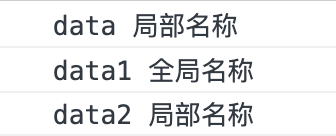概念
bind
语法:
function.bind(thisArg[, arg1[, arg2[, ...]]])
| 参数 | 说明 |
|---|---|
| thisArg | 调用绑定函数时作为 this 参数传递给目标函数的值。 如果使用new运算符构造绑定函数,则忽略该值。当使用 bind 在 setTimeout 中创建一个函数(作为回调提供)时,作为 thisArg 传递的任何原始值都将转换为 object。如果 bind 函数的参数列表为空,或者thisArg是null或undefined,执行作用域的 this 将被视为新函数的 thisArg。 |
| arg1, arg2, … | 参数 |
返回值:
返回一个原函数的拷贝,并拥有指定的 this 值和初始参数。
call
语法:
function.call(thisArg, arg1, arg2, ...)
| 参数 | 说明 |
|---|---|
| thisArg | 可选的。在 function 函数运行时使用的 this 值。请注意,this可能不是该方法看到的实际值:如果这个函数处于非严格模式下,则指定为 null 或 undefined 时会自动替换为指向全局对象,原始值会被包装。 |
| arg1, arg2, … | 指定的参数列表。 |
返回值:
使用调用者提供的 this 值和参数调用该函数的返回值。若该方法没有返回值,则返回 undefined。
apply
语法:
func.apply(thisArg, [argsArray])
| 参数 | 说明 |
|---|---|
| thisArg | 必选的。在 func 函数运行时使用的 this 值。请注意,this可能不是该方法看到的实际值:如果这个函数处于非严格模式下,则指定为 null 或 undefined 时会自动替换为指向全局对象,原始值会被包装。 |
| arg1, arg2, … | 可选的。一个数组或者类数组对象,其中的数组元素将作为单独的参数传给 func 函数。如果该参数的值为 null 或 undefined,则表示不需要传入任何参数。 |
返回值:
调用有指定this值和参数的函数的结果。
实践
bind
// 在浏览器中,this 指向全局的 "window" 对象
this.name = '全局名称';
// 局部作用域中 this 指向局部的对象
const module = {
name: '局部名称',
getName: function() {
return this.name; }
};
// 返回 '局部名称' - 因为函数是在局部作用域中调用的
const data = module.getName();
console.log('data', data)
// 返回 '全局名称' - 因为函数是在全局作用域中调用的
const getGlobalName = module.getName;
console.log('data1', getGlobalName());
// 返回 '局部名称' - 新手可能会将全局变量 name 与 module 的属性 name 混淆
// 创建一个新函数,把 'this' 绑定到 module 对象
const getLocalName = getGlobalName.bind(module);
console.log('data2', getLocalName());

call
function Product(name, price) {
this.name = name;
this.price = price;
}
function Food(name, price) {
// 相当于调用了Product并传入了name, price两个参数
Product.call(this, name, price);
this.category = 'food';
}
console.log(new Food('cheese', 5).name);
// expected output: "cheese"
apply
function Product(name, price) {
this.name = name;
this.price = price;
}
function Food(name, price) {
// 相当于调用了Product并传入了name, price两个参数
Product.apply(this, [name, price]);
this.category = 'food';
}
console.log(new Food('cheese', 5).name);
// expected output: "cheese"
总结
- call 与 apply 类似,区别就是 call 接受的是参数列表,而 apply 接受的是一个参数数组。
- bind 与(call 和 apply)相似,其作用都是用于改变函数内部 this 的指向。但是不同的是 call 与 apply 是立即执行函数而 bind 函数是将函数返回。